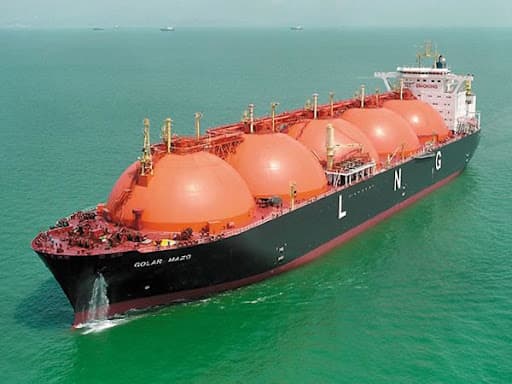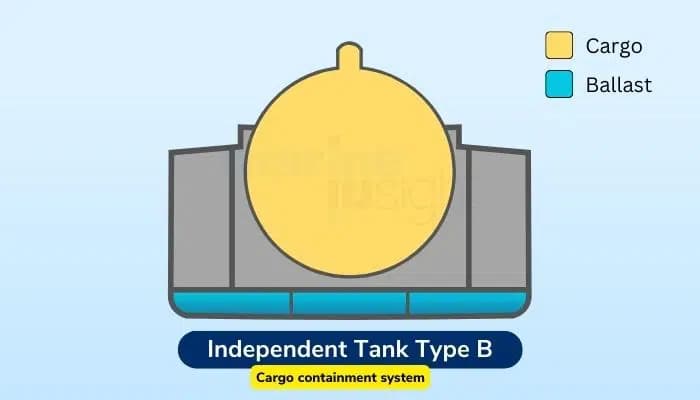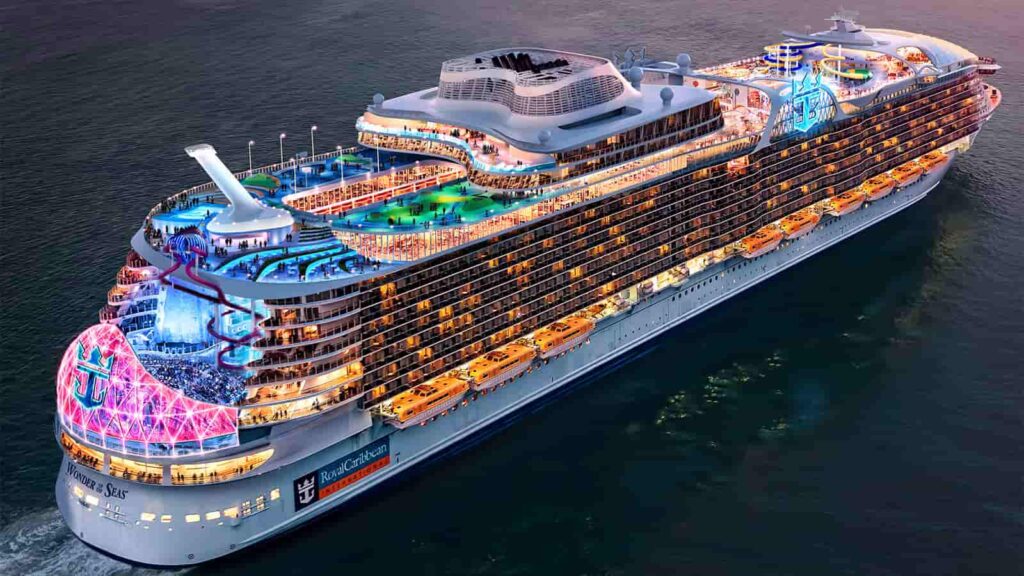Role of Gas Tankers in Transporting Liquified Gases: Gas tankers transport gases. Contrary to its name, gas tankers carry liquid cargo.
Gas tanker ships are built to store and transport liquified petroleum or chemicals.
Gas ships are as vital as oil tankers in fuel transportation.
How are they different from ordinary oil tankers?
The oil tanker holds liquefied substances including crude oil, petrol, gasoline, vegetable oils, kerosene, etc. Gas carriers use particular methods to transfer gaseous substances as liquids. We’ll discuss these particular methods later.
Oil tankers vary by size, kind, and content. The cargoes of oil vessels determine their classification as crude and refined.
While crude oil tankers transport crude, unrefined, or naturally extracted petroleum, refined oil carriers transport refined or processed petroleum products like petrol or diesel. B
There are various sizes of oil tankers, including small tankers, VLCCs, ULCCs, etc.
To properly understand gas tanker design and construction, you must first grasp their contents and chemistry.
Gas Carrier Types According to their content
Liquid Gases

Under controlled or properly planned conditions, liquefied gases can be turned into gas. They contain hydrocarbons and have significant calorific value, making them fuels. Vapour pressure is important even though we don’t cover liquified gas chemistry.
Fishing Vessels: Boats and Ships for Catching Fish in Lakes, Seas, and Rivers
Vapour pressure is the equilibrium pressure of a gaseous substance above its liquid in a closed system at a particular temperature. Equivalently, it measures the tendency of a liquid to evaporate into gas and is directly related to temperature.
A substance’s boiling point is the temperature at which its vapour pressure equals air pressure. Water vapour pressure is the pressure imposed by water vapours above a closed container half full of water at room temperature on the liquid surface below. Vapour pressure rises proportionally with temperature. At 100 degrees centigrade, water vapourizes, making it the boiling point.
Water vapour pressure equals air pressure at this point. Simply put, a gaseous substance becomes liquid below a specific temperature and vapour pressure. The International Maritime Organization (IMO) requires liquified gases to have a vapour pressure over 2.8 bars at 37.8 degrees centigrade for practical purposes.
Thus, only in those cases may the substance be gaseous and require special methods to liquidify. Otherwise, it counts as liquid! Propane has 13 bars of vapour pressure, while ammonia has 14.7 bars. Thus, they are usually gaseous and simply need particular storage methods to become a finite-volume liquid.
LNG Tankers
The fuel economy relies heavily on LNG, or Liquified Natural Gas. LNG has several uses, from residential to industrial to commercial. The main sources include subsurface reservoirs, oil fields, and seabeds.
Before shipping by water, it must be liquefied via cascade or refrigerant processes, which we will not discuss. LNG carriers are mostly methane, 70–99%. Reports say LNG carriers carry 80 million tonnes of cargo annually, rising due to worldwide demand. More than 200 LNG carriers are registered.
LPG Carriers
They dominate the gas tanker fleet. Over 800 LPG carriers are registered. Primarily propane, butane, butadiene, propylene, and anhydrous ammonia. The sea transports over 45 million tonnes of LPG gas annually.
Natural Gas Tankers
These tankers transport methane, ethane, LPG, gasoline, and crude oil.
Chemical gases
The major components are ammonia, ethylene, and vinyl chloride.
A key agricultural component, ammonia is utilized as fertilizer. It is utilized as a refrigerant in explosives and other industries.
In the synthetic industry, ethylene is used to make plastic, ethyl alcohol, and antifreeze. Reports say 3 million tonnes are shipped by sea annually.
Propylene: Like ethylene, this is widely used in plastics and manufacturing. 1.5 million tons of propylene are used in liquified gas transport via sea.
Vinyl Chloride: This chlorine liquified gas is used to make thermoplastic, mostly PVC, a global market for all sectors. They are denser than other liquified gases. Sea transport is about 2 million tonnes.
Gas Tankers by Hazard Level
Gas tanker ship design codes identify them by hazard:
Type 1G: They transport the most dangerous cargo. LNG and LPG dominate this category.
Type 2G and 2PG: Less dangerous than Type 1. This includes most chemical transporters.
The safest liquified gaseous material is Type 3G.
Gas Carriers’ Capacity and Storage
This categorization method is the most essential and provides a deep look at gas tanker ship design. Gas tanker ships may hold 500 to 100000 cubic meters of cargo. Modern LNG tankers may hold 150000 cubic metres. The largest tankers transport bulk LNG and LPG.
The global LNG and LPG fleet exceeds 1000 vessels. As hazardous carriers, gas tanker ships must fit their contents in enormous center tanks. Modern oil tankers store cargo in their central tanks and use the side and bottom tanks for ballast water and other services.
Gas carrier vessels use a complex mechanism to maintain cargo pressures, unlike oil tankers. All ambient air disturbance repels them while they are liquid. They should be tightly confined and kept in optimal circumstances. They also lack venting and ventilation systems to prevent inflammability and other risks.
In contrast, oil tankers must have venting systems to release trapped oil vapours and prevent inflammability due to the rising inert pressure of the vapours.
Gas tanker ships are designed and built according to the International Maritime Organization’s IMO Gas Codes, which address danger, safety, and cargo storage.
Q-Max Ships: Qatar Gas Consortium’s Largest LNG Carriers with Unique Design
Gas Tanker Ships Based on Tank Pressurization and Temperature
Fully pressurized ships
LPG, the first seaborne liquefied gas, is their main cargo. A fully pressurized environment with a constant low temperature keeps cargo liquid without evaporating into gas. Cargo tanks are usually spherical or cylindrical pressure cylinders or domes. Each tank typically holds 5000–6000 cubic metres, while some contemporary designs hold up to 10000.
Semi-Pressurized Ships
After fully pressurized vessels were introduced, these ships were built to address the high costs and lack of suitable materials to sustain liquified gas temperatures. Due to reliquification plants and other insulation, these tanks do not need to be continuously pressurized. If liquid turns into gas, re-liquefication technologies can turn it back into liquid. Insulation also keeps temperatures down. They have tank capacities of 5000 to 20000 cubic metres and are constructed like fully pressured vessels.
Fully-cooled vessels
Fully refrigerated ships became common in the second half of the 20th century as refrigerating technology improved. They use advanced technologies to keep tank temperatures ultra-low, allowing them to transport LNG and LPG in quantity. Modern refrigerated vessels can hold 100000-150000 cubic metres of liquid cargo due to their tanks. They also use cutting-edge insulation.
Although tank construction varies by vessel and cargo, liquified gas tanks have an internal cargo space, insulations and membrane walls, marginal spaces outside the tank boundary, and structural supports connected to the main hull structure.
Type ‘A’ tanks are used in gas tanker ships.
Type ‘A’ tanks

They look like classic oil tankers and bulk carriers. The tank walls are flat and uncurved. Prism tanks are typical of completely refrigerated containers. The space or tanks between the tank(s) and the outside shell are commonly used for ballast, and suitable materials touch the outer edge of the walls.
Tank type ‘B’

LNG is transported in these spherical or dome-shaped vessels.
Type ‘C’ tanks

These tanks are pressurized or semi-pressurized. These are usually spherical or cylindrical. They carry liquified gases at low temperatures as needed.


